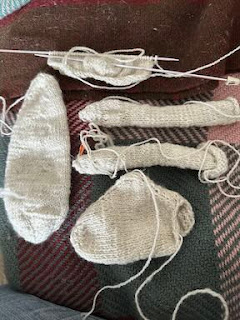Generally these days, we wash our sheep's fleeces before carding and spinning. Greasy fleeces used to be a "thing", especially in the 70's when there was a crafty revival and people were teaching themselves crafts without all the resources we have today. However, spinning fleece in the grease generally leaves your equipment dirty and it's a pain to clean. Why am I writing this post explaining this and more? Because today, while finishing washing up the last of the black fleece, I came across a little note that had the date the fleece was skirted and then a small added scribbled "washed" below it. I didn't realise the fleece had been washed already. Yes, there was less lanolin in it than the other two fleeces. However, it still had some lanolin and it was obviously dirty. While this fleece may have been washed, it wasn't washed properly. I'm going to explain a simple way to wash fleeces. There are other ways to wash fleeces but this is a pretty basic method which is effective.
First thing to know. Lanolin needs hot water and soap to be removed. The water needs to be at least 120F, to "melt" off the fibre. A bit hotter is better so that you have some working time. If the water cools too quickly, it may settle back on the fibre. If your hot water source isn't hot enough as some water heaters have safety measures of lower temperatures, you need to heat up water on the stove or in your kettle to add. While I'm using a laundry tub for this demo, this applies to using your top loading washer if you're using it to soak and spin your fleece.
 |
| Washed fleece should not be this dirty! |
Next you'll need soap. A high quality dish soap like Dawn for Fairy, Orvus or other quality animal shampoo or a wool wash. I don't use wool wash because it's way out of my price range, but I've seen some results and it works well. I also use a citrus degreaser in the first and sometimes 2nd wash. I use Zep, because it's available locally, in 4 litre containers at the big box hardware store and smaller amounts available at a local hardware chain. This is effective in the first wash to help remove the lanolin and some of the excess dirt. I usually use a glug or two of Zep and about 2 or 3 tbsp of Dawn in the first wash, along with only hot water.
Remember - felting is caused by 2 things. First, is agitation. Be gentle when you move the fibre through the water. The second, is temperature changes. It's not hot water that shrinks sweaters, but going from a hot wash to a cold rinse, or the agitation cycle of the washing machine. You always need to be careful that the water temperatures remain close to the same, or if you leave for a while, that you use the same temperature water as you just drained out.
Start the hot water and add the soap and degreaser, or wool wash. Once the tub is full, gently press in some fleece. Don't over load the tub. You want enough fleece to be a full layer, allowing enough depth in the water for water to move through the fleece and not be bogged down with depth. This will help get the dirt and lanolin out of the fleece. It usually takes several washings to get the dirt out of the fleece and then several rinses to remove the soap. I found so many short cuts and neppy bits with this fleece that I ended up repurposing my little strainer to scoop up as many bits as I could.
Non-scientific explanation of how the soap does it's job when washing fleece - When the water is hot enough for the lanolin to melt and has enough soap etc, the lanolin gets attached to the soap and the soap gets attached to the water. This means when you drain the tub, the lanolin gets washed away with the water. The soap is hydrophilic and hydrophobic which is the science stuff you need. The soap will do the same to a lot of the dirt.
Once the wash water is clear or at least clearish, you can start rinsing. Remember the water temperature should be similar to what you just used. Washing should be in hot water, but rinsing just needs to be in similar temperatures to the water as it's cooling down. Here you can see that there is still soap in the water and some dirt or dirty water being removed, so it will need another rinse.
Once the rinse water is clear and not soapy, you're almost finished. Now you need to gently squeeze out the excess water. You can do this with a towel, or if you have a mesh bag, you can put the wet wool in it, go outside and use centrifugal force by whizzing it over your head to remove the water. If you have. a fancy extractor that works well. I have an old lettuce spinner which does the trick, although it's a slower solution.
Dirt left in the bottom of the tub, from the supposedly washed fleece. Just no- this will muck up your hand cards or drum carder. If your fleece has this much dirt left in it, you need to wash it again!
I'm a bit ticked because I shouldn't have had to rewash the fleece, if it had been done properly in the first place. I'm glad I hadn't noticed that it was supposedly washed because I would have hated to run that through a friend's equipment.












